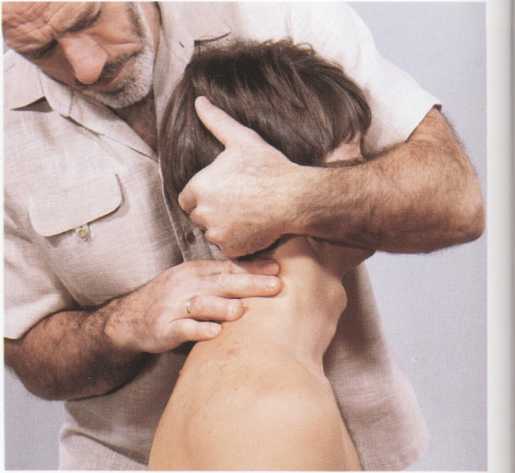54 (307)

3.5.5A. Non-specific technique for the deep ventral muscles to increase dorsal flexion
(mainly the longus colli at C2 on
C3).
P sitting.
Starting Position: P: Sitting; upper thoracic region well supported caudal to and including T3. T: Standing facing P’s left side.
Grip: Ts left hand grips around the right side of P’s head with the little finger along P’s axis (C2). T's right index finger and thumb stabilize C3 from the dorsal aspect. P’s head is held firmly against T’s chest. T’s left palm cups comfortably over P’s right ear, with hand and arm positioned to avoid uncomfortable pressure on P’s mandible.
Procedurę: Using this grip, T applies traction, and then maintaining this traction, moves his/her body to gradually and fully dorsally flex C2 on C3.
Stimulation of Antagonists: T retains grip, and asks P to look upwards and backwards, and then move head and cervical spine in the direction just stretched. T resists that movement to stimulate P’s antagonists.
Notes: The longus colli originates at T3. Therefore P’s thoracic spine should be supported at and caudal to this level.
When treating the segments caudal to C3, T's left hand grips the cranial vertebra of the segment treated, and T's right hand stabilizes the caudal vertebra. For ease of grip and efficiency of treatment, T may position the segments cranial to C3 in ventral flexion.

Fig. 38 a. Starting Position.

Fig. 38 b. Finał Position.
-
54
Wyszukiwarka
Podobne podstrony:
56 (315) 3.5.5C. Non-specific technique for the deep ventral muscles to increase dorsal flexion
57 (308) 3.5.5D. Non-specific techniąue for the deep ventral muscles to increase dorsal flexion
55 (318) 3.5.5B. Non-specific technique for the deep ventral muscles to increase dorsal flexion
52 (333) 3.5.4A. Non-specific technique for the super-ficial ventral muscles to increase dorsal flex
53 (315) 3.5.4B. Non-specific techniąue for the super-ficial ventral muscles to increase dorsal flex
58 (289) 3.6.1A. Non-specific techniąue to increase dorsal flexion with rotation and later-al flexio
64 (250) 3.7.1A. Non-specific technique to increase dorsal flexion with rotation to the right a
65 (245) 3.7.IB. Non-specific techniąue to increase dorsal flexion with rotation to the right a
66 (237) 3.7.1C. Non-specific techniąue to increase dorsal flexion with rotation to the right a
60 (278) 3.6.2A. Specific technique to increase dorsal flexion with rotation and lateral flex-ion to
61 (265) 3.6.2B. Specific techniąue to increase dorsal flexion with rotation and lateral flex-ion to
62 (263) 3.6.2C. Specific techniąue to increase dorsal flexion with rotation and lateral flex-ion to
63 (253) 3.6.2D. Specific technique to increase dorsal flexion with rotation and lateral flex-ion to
67 (234) 3.7.2A1. Specific technique to increase dorsal flexion with rotation to the right and
68 (230) 3.7.2A2. Specific techniąue to increase dorsal flexion with rotation to the right and
69 (224) 3.7.2B. Specific techniąue to increase dorsal flexion with rotation to the right and l
71 (223) 3.7.2D. Specific techniąue to increase dorsal flexion with rotation to the right and l
45 (421) 3.5.1. Non-specific techniąue to increase dorsal flexion. P supine. Starting Position: P: S
46 (412) 3.5.2A. Specific technique to increase dorsal flexion of the occiput on the atlas. P sittin
więcej podobnych podstron